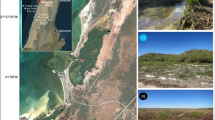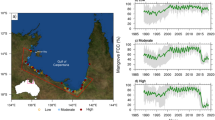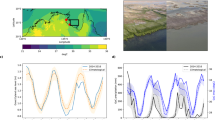Abstract
Mangroves are a carbon-dense and highly productive ecosystem but can experience massive dieback under environmental extremes. Climatic oscillations, such as the El Niño–Southern Oscillation (ENSO), are major drivers of global climate variability, yet their impact on mangrove growth at the global scale remains uncertain. Here, using long-term satellite observations from 2001 to 2020, we show that more than 50% of global mangrove areas experience significant variations during ENSO events, exhibiting a seesaw-like pattern across the Pacific Basin where mangrove leaf area decreases in the western Pacific but increases in the eastern Pacific during El Niño, with the reverse occurring during La Niña. The Indian Ocean Dipole affects mangroves across the Indian Ocean similarly but with a lower magnitude relative to ENSO. These patterns are driven by corresponding sea-level fluctuations across the Pacific and Indian ocean basins, with local contributions from lunar nodal cycles. Our study highlights the crucial role of short-term sea-level fluctuations driven by climatic oscillations in dominating the variability of coastal wetland growth and, consequently, in influencing the blue carbon sink.
This is a preview of subscription content, access via your institution
Access options
Access Nature and 54 other Nature Portfolio journals
Get Nature+, our best-value online-access subscription
$32.99 / 30 days
cancel any time
Subscribe to this journal
Receive 12 print issues and online access
$259.00 per year
only $21.58 per issue
Buy this article
- Purchase on SpringerLink
- Instant access to full article PDF
Prices may be subject to local taxes which are calculated during checkout




Similar content being viewed by others
Data availability
All data used in this study are publicly available. The GLASS V6 LAI data are available at http://www.glass.umd.edu/LAI/MODIS/250m/. The Global Mangrove Watch v3.0 data are available via Zenodo at https://doi.org/10.5281/zenodo.6894273 (ref. 61). Gridded climate data used in this study are presented in Supplementary Table 2.
Code availability
All code used in this study is available from the corresponding authors upon reasonable request.
References
McPhaden, M. J., Zebiak, S. E. & Glantz, M. H. ENSO as an integrating concept in Earth science. Science 314, 1740–1745 (2006).
Saji, N. H., Goswami, B. N., Vinayachandran, P. N. & Yamagata, T. A dipole mode in the tropical Indian Ocean. Nature 401, 360–363 (1999).
Barber, R. T. & Chavez, F. P. Biological consequences of El Niño. Science 222, 1203–1210 (1983).
Lovelock, C. E. & Reef, R. Variable impacts of climate change on blue carbon. One Earth 3, 195–211 (2020).
Johannessen, S. C. & Christian, J. R. Why blue carbon cannot truly offset fossil fuel emissions. Commun. Earth Environ. 4, 411 (2023).
Worthington, T. A. et al. Harnessing big data to support the conservation and rehabilitation of mangrove forests globally. One Earth 2, 429–443 (2020).
Cai, W. et al. Increasing frequency of extreme El Niño events due to greenhouse warming. Nat. Clim. Change 4, 111–116 (2014).
Cai, W. et al. Increased frequency of extreme La Niña events under greenhouse warming. Nat. Clim. Change 5, 132–137 (2015).
Zhang, Z. et al. Stronger increases but greater variability in global mangrove productivity compared to that of adjacent terrestrial forests. Nat. Ecol. Evol. 8, 239–250 (2024).
Friess, D. A., Adame, M. F., Adams, J. B. & Lovelock, C. E. Mangrove forests under climate change in a 2 °C world. Wiley Interdiscip. Rev. Clim. Change 13, e792 (2022).
Duke, N. C. et al. Large-scale dieback of mangroves in Australia. Mar. Freshw. Res. 68, 1816–1829 (2017).
Sippo, J. Z., Lovelock, C. E., Santos, I. R., Sanders, C. J. & Maher, D. T. Mangrove mortality in a changing climate: an overview. Estuar. Coast. Shelf Sci. 215, 241–249 (2018).
Asbridge, E. F. et al. Assessing the distribution and drivers of mangrove dieback in Kakadu National Park, northern Australia. Estuar. Coast. Shelf Sci. 228, 106353 (2019).
Lovelock, C. E., Feller, I. C., Reef, R., Hickey, S. & Ball, M. C. Mangrove dieback during fluctuating sea levels. Sci. Rep. 7, 1680 (2017).
Timmermann, A. et al. El Niño–Southern Oscillation complexity. Nature 559, 535–545 (2018).
Duke, N. C. et al. ENSO-driven extreme oscillations in mean sea level destabilise critical shoreline mangroves—an emerging threat. PLoS Clim. 1, e0000037 (2022).
Hickey, S. M. et al. ENSO feedback drives variations in dieback at a marginal mangrove site. Sci. Rep. 11, 8130 (2021).
Abhik, S. et al. Influence of the 2015–2016 El Niño on the record-breaking mangrove dieback along northern Australia coast. Sci. Rep. 11, 20411 (2021).
Saintilan, N. et al. The lunar nodal cycle controls mangrove canopy cover on the Australian continent. Sci. Adv. 8, eabo6602 (2022).
Palmer, P. I. et al. Drivers and impacts of Eastern African rainfall variability. Nat. Rev. Earth Environ. 4, 254–270 (2023).
Ratna, S. B., Cherchi, A., Osborn, T. J., Joshi, M. & Uppara, U. The extreme positive Indian Ocean Dipole of 2019 and associated Indian summer monsoon rainfall response. Geophys. Res. Lett. 48, e2020GL091497 (2021).
Ma, H. & Liang, S. Development of the GLASS 250-m leaf area index product (version 6) from MODIS data using the bidirectional LSTM deep learning model. Remote Sens. Environ. 273, 112985 (2022).
Satriawan, T. W. et al. Strong green-up of tropical Asia during the 2015/16 El Niño. Geophys. Res. Lett. 51, e2023GL106955 (2024).
Janssen, T. et al. Drought effects on leaf fall, leaf flushing and stem growth in the Amazon forest: reconciling remote sensing data and field observations. Biogeosciences 18, 4445–4472 (2021).
Servino, R. N., Gomes, L. E., de, O. & Bernardino, A. F. Extreme weather impacts on tropical mangrove forests in the Eastern Brazil Marine Ecoregion. Sci. Total Environ. 628–629, 233–240 (2018).
Otero, X. L. et al. High fragility of the soil organic C pools in mangrove forests. Mar. Pollut. Bull. 119, 460–464 (2017).
Drexler, J. Z. & Ewel, K. C. Effect of the 1997–1998 ENSO-related drought on hydrology and salinity in a micronesian wetland complex. Estuaries 24, 347–356 (2001).
Carruthers, L. et al. Sea-level rise and extreme Indian Ocean Dipole explain mangrove dieback in the Maldives. Sci. Rep. 14, 27012 (2024).
Bunting, P. et al. The Global Mangrove Watch—a new 2010 global baseline of mangrove extent. Remote Sens. 10, 1669 (2018).
Slette, I. J. et al. How ecologists define drought, and why we should do better. Glob. Change Biol. 25, 3193–3200 (2019).
Vecchi, G. A. et al. Weakening of tropical Pacific atmospheric circulation due to anthropogenic forcing. Nature 441, 73–76 (2006).
Merrifield, M. A., Thompson, P. R. & Lander, M. Multidecadal sea level anomalies and trends in the western tropical Pacific. Geophys. Res. Lett. 39, L13602 (2012).
Widlansky, M. J., Timmermann, A. & Cai, W. Future extreme sea level seesaws in the tropical Pacific. Sci. Adv. 1, e1500560 (2015).
Adame, M. F. et al. Mangroves in arid regions: ecology, threats, and opportunities. Estuar. Coast. Shelf Sci. 248, 106796 (2021).
Zhu, X., Sun, C. & Qin, Z. Drought‐induced salinity enhancement weakens mangrove greenhouse gas cycling. J. Geophys. Res. Biogeosci. 126, e2021JG006416 (2021).
Bathmann, J. et al. Modelling mangrove forest structure and species composition over tidal inundation gradients: the feedback between plant water use and porewater salinity in an arid mangrove ecosystem. Agric. Meteorol. 308–309, 108547 (2021).
Hoppe-Speer, S. C. L., Adams, J. B., Rajkaran, A. & Bailey, D. The response of the red mangrove Rhizophora mucronata Lam. to salinity and inundation in South Africa. Aquat. Bot. 95, 71–76 (2011).
Ball, M. C. & Farquhar, G. D. Photosynthetic and stomatal responses of two mangrove species, Aegiceras corniculatum and Avicennia marina, to long term salinity and humidity conditions. Plant Physiol. 74, 1–6 (1984).
Méndez-Alonzo, R., López-Portillo, J., Moctezuma, C., Bartlett, M. K. & Sack, L. Osmotic and hydraulic adjustment of mangrove saplings to extreme salinity. Tree Physiol. 36, 1562–1572 (2016).
Wang, J. et al. Modulation of land photosynthesis by the Indian Ocean Dipole: satellite-based observations and CMIP6 future projections. Earth Future 9, e2020EF001942 (2021).
Ruehr, S. et al. Evidence and attribution of the enhanced land carbon sink. Nat. Rev. Earth Environ. 4, 518–534 (2023).
Goldberg, L., Lagomasino, D., Thomas, N. & Fatoyinbo, T. Global declines in human‐driven mangrove loss. Glob. Change Biol. 26, 5844–5855 (2020).
Bunting, P. et al. Global mangrove extent change 1996–2020: Global Mangrove Watch Version 3.0. Remote Sens. 14, 3657 (2022).
Kamal, M., Phinn, S. & Johansen, K. Assessment of multi-resolution image data for mangrove leaf area index mapping. Remote Sens. Environ. 176, 242–254 (2016).
Xiao, J. et al. Remote sensing of the terrestrial carbon cycle: a review of advances over 50 years. Remote Sens. Environ. 233, 111383 (2019).
Hawman, P. A., Mishra, D. R. & O'Connell, J. L. Dynamic emergent leaf area in tidal wetlands: implications for satellite-derived regional and global blue carbon estimates. Remote Sens. Environ. 290, 113553 (2023).
Justice, C. O. et al. An overview of MODIS Land data processing and product status. Remote Sens. Environ. 83, 3–15 (2002).
Tang, Y. et al. Mango-GPP: a process-based model for simulating gross primary productivity of mangrove ecosystems. J. Adv. Model. Earth Syst. 15, e2023MS003714 (2023).
Gou, R. et al. Atmospheric water demand constrains net ecosystem production in subtropical mangrove forests. J. Hydrol. 630, 130651 (2024).
Vicente-Serrano, S. M., Beguería, S. & López-Moreno, J. I. A multiscalar drought index sensitive to global warming: the Standardized Precipitation Evapotranspiration Index. J. Clim. 23, 1696–1718 (2010).
Rienecker, M. M. et al. MERRA: NASA’s Modern-Era Retrospective Analysis for Research and Applications. J. Clim. 24, 3624–3648 (2011).
Beguería, S., Vicente-Serrano, S. M. & Angulo-Martínez, M. A multiscalar global drought dataset: the SPEIbase: a new gridded product for the analysis of drought variability and impacts. Bull. Am. Meteorol. Soc. 91, 1351–1356 (2010).
Guinehut, S., Dhomps, A.-L., Larnicol, G. & Le Traon, P.-Y. High resolution 3-D temperature and salinity fields derived from in situ and satellite observations. Ocean Sci. 8, 845–857 (2012).
Rovai, A. S. et al. Macroecological patterns of forest structure and allometric scaling in mangrove forests. Glob. Ecol. Biogeogr. 30, 1000–1013 (2021).
Almar, R. et al. Influence of El Niño on the variability of global shoreline position. Nat. Commun. 14, 3133 (2023).
Yan, R. et al. Interactive effects of the El Niño–Southern Oscillation and Indian Ocean Dipole on the tropical net ecosystem productivity. Agric. Meteorol. 336, 109472 (2023).
Enríquez, A. R. et al. Predictable changes in extreme sea levels and coastal flood risk due to long-term tidal cycles. J. Geophys. Res. Oceans 127, e2021JC018157 (2022).
Peng, D., Hill, E. M., Meltzner, A. J. & Switzer, A. D. Tide gauge records show that the 18.61-year nodal tidal cycle can change high water levels by up to 30 cm. J. Geophys. Res. Oceans 124, 736–749 (2019).
Chen, C., Riley, W. J., Prentice, I. C. & Keenan, T. F. CO2 fertilization of terrestrial photosynthesis inferred from site to global scales. Proc. Natl Acad. Sci. USA 119, e2115627119 (2022).
Kim, J.-S., Kug, J.-S. & Jeong, S.-J. Intensification of terrestrial carbon cycle related to El Niño–Southern Oscillation under greenhouse warming. Nat. Commun. 8, 1674 (2017).
Bunting, P. et al. Global Mangrove Watch (1996–2020) version 3.0 dataset. Zenodo https://doi.org/10.5281/zenodo.6894273 (2022).
Duke, N. C., Ball, M. C. & Ellison, J. C. Factors influencing biodiversity and distributional gradients in mangroves. Glob. Ecol. Biogeogr. Lett. 7, 27–47 (1998).
Acknowledgements
Y.L. acknowledges the support from the National Natural Science Foundation of China Grants (grant no. 42276232). D.F. thanks M. and M. Cochran for endowing the Cochran Family Professorship in Earth and Environmental Sciences at Tulane University. We thank W. Cai at the Commonwealth Scientific and Industrial Research Organisation (CSIRO) for his feedback on an earlier version of this work.
Author information
Authors and Affiliations
Contributions
Z.Z. conceptualized the study. Z.Z. and Y.L. designed the study. Z.Z. performed the analysis and drafted the paper with contributions from all other co-authors. All authors contributed to the interpretation of the results. Y.L. is the main corresponding author of the study.
Corresponding authors
Ethics declarations
Competing interests
The authors declare no competing interests.
Peer review
Peer review information
Nature Geoscience thanks Norman Duke, Melinda Martinez and the other, anonymous, reviewer(s) for their contribution to the peer review of this work. Primary Handling Editor: Xujia Jiang, in collaboration with the Nature Geoscience team.
Additional information
Publisher’s note Springer Nature remains neutral with regard to jurisdictional claims in published maps and institutional affiliations.
Extended data
Extended Data Fig. 1 Distribution of mangroves within six biogeographic regions.
This map was adopted from ref. 62.
Extended Data Fig. 2 Local-scale mangrove variation in response to ENSO.
ΔEVI (average EVI during ENSO event minus average EVI during neutral periods) in (a) Shoalwater Bay, Australia, and (b) Gulf of California, Mexico. The left panels show Landsat results at 30-m resolution. The other three-column panels show MODIS results at 250-m resolution with three different criteria to define mangrove extents. The right panels show results for pure mangrove pixels (mangrove coverage > 80%) at 250-m resolution, which is used in the main analysis. Areas with green color represent mangroves with enhanced growth, and red color indicates mangrove degradation during the ENSO event.
Extended Data Fig. 3 Observed spatial patterns of changes in climatic and oceanic factors corresponding to 2015-2016 El Niño.
Changes in anomaly (z-score) of mean monthly (a) air temperature, (b) SPEI, (c) wind speed, (d) sea surface temperature, (e) sea surface salinity, and (f) sea-level anomaly are shown. Pie plots indicate the area-weighted proportion of grid cells with significantly increased LAI (green), significantly decreased LAI (purple), or no significant difference with neutral phases (grey) (P > 0.05).
Extended Data Fig. 4 Observed spatial patterns of changes in climatic and oceanic factors corresponding to 2010-2012 La Niña.
Changes in anomaly (z-score) of mean monthly (a) air temperature, (b) SPEI, (c) wind speed, (d) sea surface temperature, (e) sea surface salinity, and (f) sea-level anomaly are shown. Pie plots indicate the area-weighted proportion of grid cells with significantly increased LAI (green), significantly decreased LAI (purple), or no significant difference with neutral phases (grey) (P > 0.05).
Extended Data Fig. 5 Observed spatial patterns of changes in climatic and oceanic factors corresponding to 2019 pIOD.
Changes in anomaly (z-score) of mean monthly (a) air temperature, (b) SPEI, (c) wind speed, (d) sea surface temperature, (e) sea surface salinity, and (f) sea-level anomaly are shown. Pie plots indicate the area-weighted proportion of grid cells with significantly increased LAI (green), significantly decreased LAI (purple), or no significant difference with neutral phases (grey) (P > 0.05).
Extended Data Fig. 6 Each term in Eq. (4) plotted as a contribution to ΔLAI anomaly in the response to 2015-2016 El Niño.
The contribution is calculated as the product of mangrove sensitivity to (a) air temperature, (b) SPEI, (c) wind speed, (d) sea surface temperature, (e) sea surface salinity, and (f) sea-level anomaly and El Niño-induced anomaly in these factors.
Extended Data Fig. 7 Each term in Eq. (4) plotted as a contribution to ΔLAI anomaly in the response to 2010-2012 La Niña.
The contribution is calculated as the product of mangrove sensitivity to (a) air temperature, (b) SPEI, (c) wind speed, (d) sea surface temperature, (e) sea surface salinity, and (f) sea-level anomaly and La Niña-induced anomaly in these factors.
Extended Data Fig. 8 Dominant driver of sea level anomaly during climatic events.
The dominant component driving SLA during (a) 2015-2016 El Niño, (b) 2010-2012 La Niña, and (c) 2019 pIOD. In (a) and (b), the left pie charts represent results from Indo-Malesia and Australasia, while in (c), the left pie chart shows results from eastern Africa. The right pie charts in (a) and (b) depict results from western America, while in (c), the right pie chart shows results from Indo-Malesia and Australasia. The red areas in the charts denote regions where SLA is predominantly influenced by climatic oscillations, and the blue areas indicate regions where the nodal cycle is the dominant factor. Specific spatial details of SLA contributed by climatic oscillations and nodal cycle are shown in Supplementary Fig. 8.
Extended Data Fig. 9 Each term in Eq. (4) plotted as a contribution to ΔLAI anomaly in the response to 2019 pIOD.
The contribution is calculated as the product of mangrove sensitivity to (a) air temperature, (b) SPEI, (c) wind speed, (d) sea surface temperature, (e) sea surface salinity, and (f) sea-level anomaly and pIOD-induced anomaly in these factors.
Supplementary information
Supplementary Information
Supplementary Figs. 1–11 and Tables 1–3.
Rights and permissions
Springer Nature or its licensor (e.g. a society or other partner) holds exclusive rights to this article under a publishing agreement with the author(s) or other rightsholder(s); author self-archiving of the accepted manuscript version of this article is solely governed by the terms of such publishing agreement and applicable law.
About this article
Cite this article
Zhang, Z., Luo, X., Friess, D.A. et al. Global mangrove growth variability driven by climatic oscillation-induced sea-level fluctuations. Nat. Geosci. 18, 488–494 (2025). https://doi.org/10.1038/s41561-025-01701-8
Received:
Accepted:
Published:
Issue date:
DOI: https://doi.org/10.1038/s41561-025-01701-8



